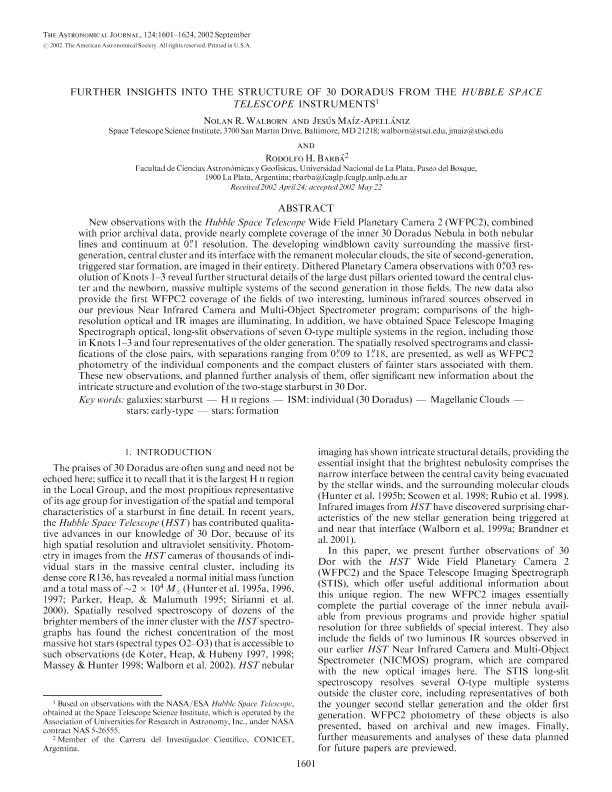Mostrar el registro sencillo del ítem
dc.contributor.author
Walborn, Nolan Revere

dc.contributor.author
Maíz Apellániz, Jesús

dc.contributor.author
Barba, Rodolfo Hector

dc.date.available
2023-10-11T13:08:01Z
dc.date.issued
2002-12
dc.identifier.citation
Walborn, Nolan Revere; Maíz Apellániz, Jesús; Barba, Rodolfo Hector; Further Insights into the Structure of 30 Doradus from the Hubble Space Telescope Instruments; IOP Publishing; Astronomical Journal; 124; 3; 12-2002; 1601-1624
dc.identifier.issn
0004-6256
dc.identifier.uri
http://hdl.handle.net/11336/214794
dc.description.abstract
New observations with the Hubble Space Telescope Wide Field Planetary Camera 2 (WFPC2), combined with prior archival data, provide nearly complete coverage of the inner 30 Doradus Nebula in both nebular lines and continuum at 0farcs1 resolution. The developing windblown cavity surrounding the massive first-generation, central cluster and its interface with the remanent molecular clouds, the site of second-generation, triggered star formation, are imaged in their entirety. Dithered Planetary Camera observations with 0farcs03 resolution of Knots 1–3 reveal further structural details of the large dust pillars oriented toward the central cluster and the newborn, massive multiple systems of the second generation in those fields. The new data also provide the first WFPC2 coverage of the fields of two interesting, luminous infrared sources observed in our previous Near Infrared Camera and Multi-Object Spectrometer program; comparisons of the high-resolution optical and IR images are illuminating. In addition, we have obtained Space Telescope Imaging Spectrograph optical, long-slit observations of seven O-type multiple systems in the region, including those in Knots 1–3 and four representatives of the older generation. The spatially resolved spectrograms and classifications of the close pairs, with separations ranging from 0farcs09 to 1farcs18, are presented, as well as WFPC2 photometry of the individual components and the compact clusters of fainter stars associated with them. These new observations, and planned further analysis of them, offer significant new information about the intricate structure and evolution of the two-stage starburst in 30 Dor.
dc.format
application/pdf
dc.language.iso
eng
dc.publisher
IOP Publishing

dc.rights
info:eu-repo/semantics/openAccess
dc.rights.uri
https://creativecommons.org/licenses/by-nc-sa/2.5/ar/
dc.subject
Hubble Space Telescope
dc.subject.classification
Astronomía

dc.subject.classification
Ciencias Físicas

dc.subject.classification
CIENCIAS NATURALES Y EXACTAS

dc.title
Further Insights into the Structure of 30 Doradus from the Hubble Space Telescope Instruments
dc.type
info:eu-repo/semantics/article
dc.type
info:ar-repo/semantics/artículo
dc.type
info:eu-repo/semantics/publishedVersion
dc.date.updated
2023-07-07T20:32:07Z
dc.journal.volume
124
dc.journal.number
3
dc.journal.pagination
1601-1624
dc.journal.pais
Reino Unido

dc.description.fil
Fil: Walborn, Nolan Revere. Space Telescope Science Institute; Estados Unidos
dc.description.fil
Fil: Maíz Apellániz, Jesús. Space Telescope Science Institute; Estados Unidos
dc.description.fil
Fil: Barba, Rodolfo Hector. Consejo Nacional de Investigaciones Científicas y Técnicas. Centro Científico Tecnológico Conicet - San Juan. Instituto de Ciencias Astronómicas, de la Tierra y del Espacio. Universidad Nacional de San Juan. Instituto de Ciencias Astronómicas, de la Tierra y del Espacio; Argentina
dc.journal.title
Astronomical Journal

dc.relation.alternativeid
info:eu-repo/semantics/altIdentifier/doi/http://dx.doi.org/10.1086/341955
dc.relation.alternativeid
info:eu-repo/semantics/altIdentifier/url/https://iopscience.iop.org/article/10.1086/341955
Archivos asociados
